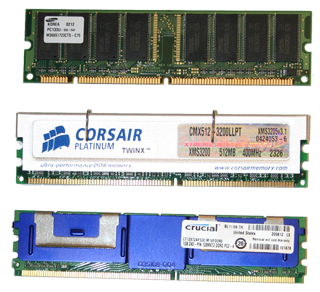Just recently I bought a 512MB DIMM to upgrade one of my PCs. It didn’t fit. Though I thought I had checked all the stats, I bought the wrong thing. Not wanting to have wasted the $60 or so I spent on the DIMM, I desperately tried to use it somewhere, anywhere, in any PC I owned. It didn’t fit in any of those computers.
So, not wanting to be wasteful (again), I figured I’d save the DIMM in a special place, just in case I could use it again in the future.
Lo, imagine my surprise when I found that special place has three other DIMMs. Orphans. Not one of them fit into any PC I own. If you examine the DIMMs (shown below), you’ll see that though they have a similar appearance, the details are subtle and insidious:

Rather than be frustrated, I did some research to help me (and you) understand the things that determine which DIMM is which. Here there are:
DIMM. A DIMM is basically a memory expansion card, about the side of a standard pocket comb but far more expensive. DIMM stands for Dual-Inline Memory Module.
Quantity. Memory is measured by bytes, and today’s computers consume memory in megabytes (MB) and gigabytes (GB). Typical DIMMs sport 128MB, 256MB, 512MB, 1GB, and 2GB quantities. Knowing which quantity to get depends both on how much memory you need as well as how memory is allocated and organized on your computer’s motherboard.
Type. There is no single type of RAM chip. Instead, you’ll find a plethora of acronyms and codes, including: EDO DRAM, SDRAM, SDR SDRAM, DDR SDRAM, DDR2 SDRAM. DDR3 SDRAM, and more! There’s no need going into the technical minutia that separates the different RAM types. Instead, use the memory that your PC craves. (I’ll explain how to find out in a second.)
Speed. Memory speed is tied to the bus speed on the motherboard. The values, whatever they are, must match. For my DIMM, I needed PC2-4200 as the speed value. I don’t know exactly what that means, but like the type of memory you need the speed that the computer hardware specifies.
Pins. Not really a pin, these are the tabs that interface between the DIMM and the slot it plugs into. The tabs are basically a thin piece of gold. Each DIMM has a given count of pins on its edge.
Notch. DIMMs sport one or more notches to ensure that the DIMM is not plugged in the wrong way.
The best way to determine what type of memory your PC has is to look. The quantity, type, and speed can often be found on a sticker on the DIMM itself. When that’s lacking, you can refer to the manufacturer’s web site or use Crucial.com‘s web site to determine what type of memory your computer needs.
After a bit of research, I determined that my PC needed a DDR2, PC2-4200 240-pin DIMM. I bought three of them at 512MB (for only $14 each), which should upgrade the computer to a full 2GB.
Now I can be happy!
A memory upgrade is perhaps the cheapest and best way to put oomph into an older PC, or any computer for that matter. For shopping, I recommend crucial.com.

